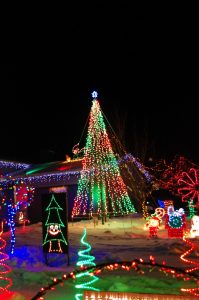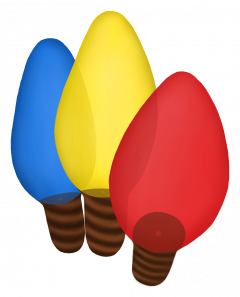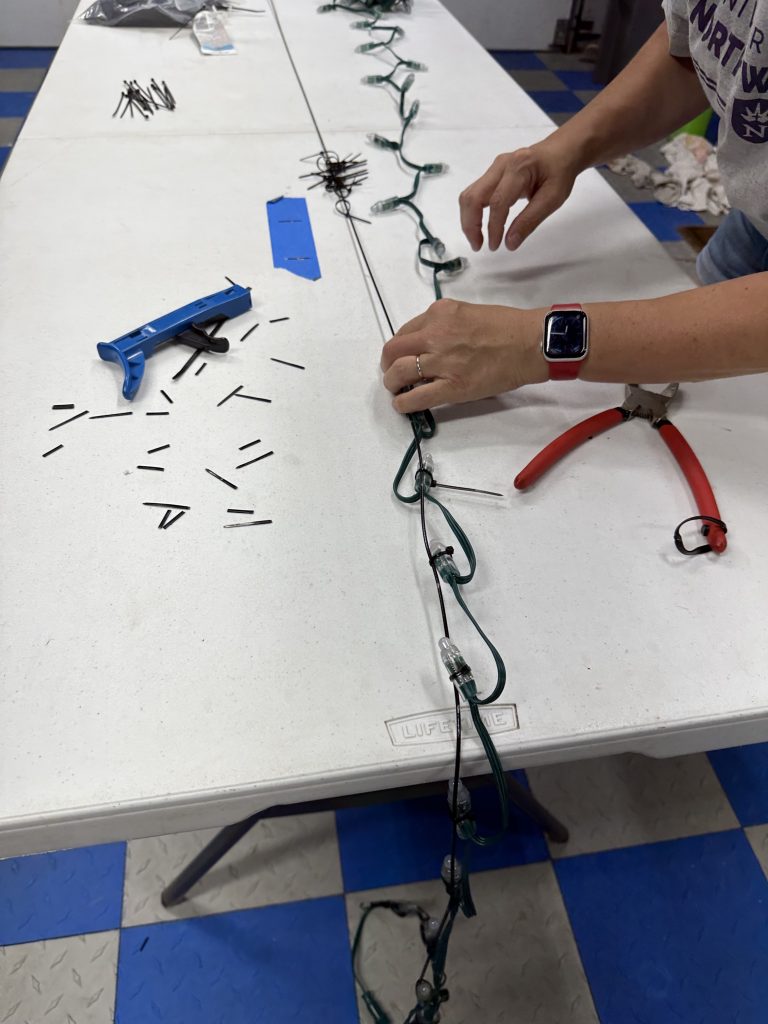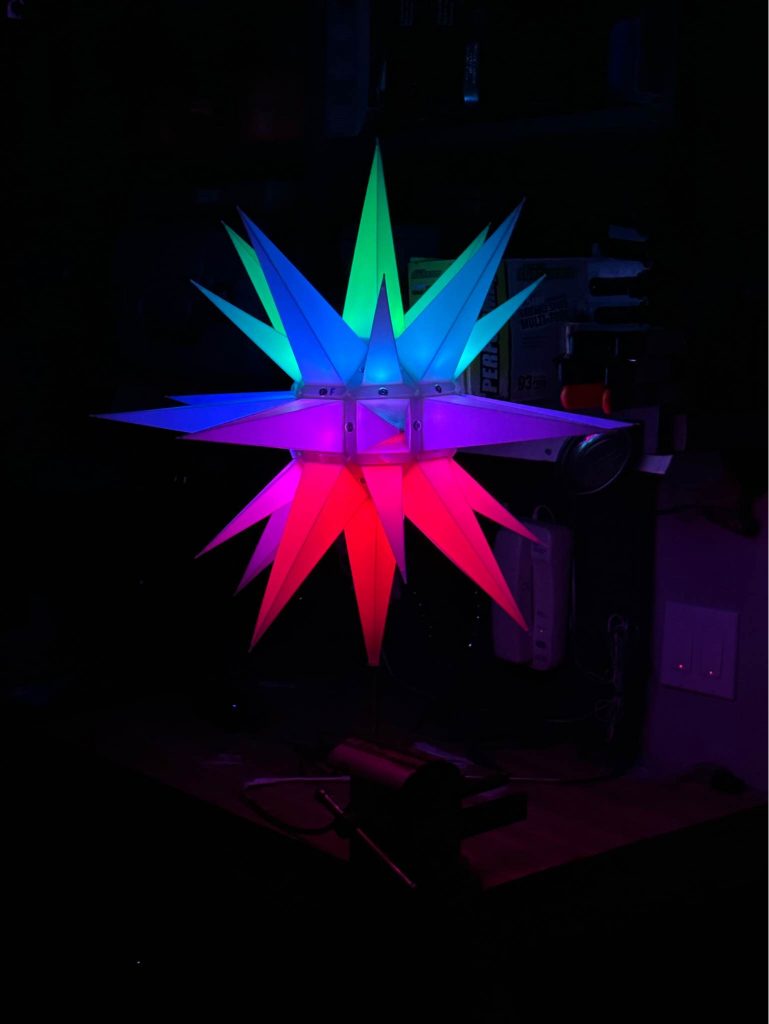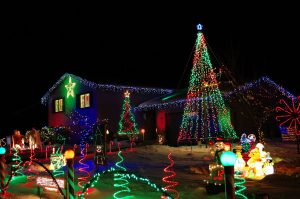
Our “Mega-Tree” was once again redesigned for the 2023 season, with all new pixel lights and a new Moravian Star. The design we used was similar to our first pixel Mega tree that made its debut in 2012. This page will describe them.
The Mega-Tree is a 20-foot, freestanding 3-dimensional Christmas tree, which thanks thanks to computer control, can animate, change colors, spin, flash, and do many other effects all synchronized to our FM radio broadcast of Christmas music. In fact, each of the 1536 individual LED bulbs on the tree can be programmed to change to virtually any color, independently of any of the other bulbs, allowing for almost limitless effects.
Our original Mega-Tree debuted in 2003, and was our first major display item that used music-synchronized computer animation. In fact, it was that tree that helped give the world the term “mega tree” which is now in standard use across displays worldwide! You can read that little story on the original Mega Tree page. It served us well for 9 seasons, but was starting to show its age. Being made of standard incandescent light strings, the color tended to wear off, and we recolored many of the bulbs with stained glass paint to keep them going (the greens especially tended to fade quickly). But for the 10th season of the tree, we knew it was time to retire those lights, which opened up the possibility of rethinking the entire tree.
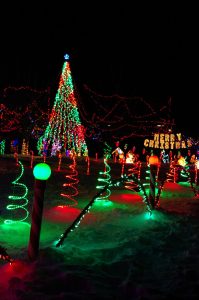
We’ve been transitioning our display to use LED light strings since about 2007. We knew that the new mega-tree would need to use LED light strings to keep this philosophy going. But LED strings tend to be expensive- which is one reason why the Mega-tree wasn’t replaced sooner. In the meantime, newer LED technologies, such as the RGB lights we used when creating our North Poles for the 2011 season, have come down in price drastically, so they were worth considering. In the end, we decided that the money would be best spent redoing the tree as a pixel tree. As noted above, this means we have individual control of every single bulb on the tree independently. What does that mean? Well there are 1536 bulbs on the tree. Each bulb has three channels of control, for Red, Green, and Blue (those primary colors can be mixed to create just about any other color). So the grand total? 4608 channels of control, just for the bulbs in the mega-tree! To put that in perspective, our old mega-tree had 36 channels of control for the lights, and our entire 2011 display had less than 250 channels of control. This is truly new territory for us.
Tim ordered a sample pixel string to test out early in the year, and also ordered a Sandevices E681 pixel controller to use to control the lights. Fortunately our Light-o-rama light control software added the capability to drive controllers such as this about the same time – Tim was actually running tests with some other software early in the year before this capability was added, but that software just wasn’t as good. It was really thrilling to have a level of control down to the bulb level- and that was just with one string! So in August we placed an order for the remaining pixel strings, and they came in mid-September. We got to work prepping them for the new tree- zip-tying them to nylon paracord (to protect the strings from too much stress), soldering on weatherproof connectors which will connect them to the new controllers, etc . We are continuing to use our telescoping flagpole and original PVC base for the support structure (see the original article for more info). Our good friend and fellow display artist Walter Monkhouse of Texas generously designed and built us a new tree topper disc which will support the light strings at the top of the pole.
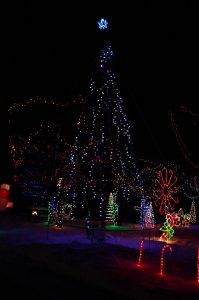
Programming 4608 channels by hand is not terribly feasible, so to better manage this, Tim wrote some code to convert the sequence files to be able to be played in the new channels. While this gave us a “baseline” to use, it didn’t take advantage of any of the new pixel-based capabilities. So Tim then went through each sequence, adding new effects where desired, changing things up a bit, aided in part by a great free sequencing tool called Nutcracker (which is now part of the xLights software package). The goal was to have a tree with the ‘spirit’ of the previous tree as far as look and feel, but with many more capabilities and much more vibrant color (as well as many new color choices).
The 2012 tree preformed great and was one of the centerpieces of our display. It was used through the 2022 season. By this time, we were spending a lot of time replacing pixel nodes due to failure (and each replacement has to be spliced in, soldering 6 wires). So it was time for another refresh.
As we were happy with the basic design, we didn’t need to change as much this time. The main change we made was using plastic coated airline cable to support the strings on the tree. The 2012 tree used paracord, which worked decent enough but we were hoping the steel cable ould allow us to align the lights better for better pixel effects. As such, we painstakingly measured each position for the 1536 pixels and individually zip-tied each to the cable.
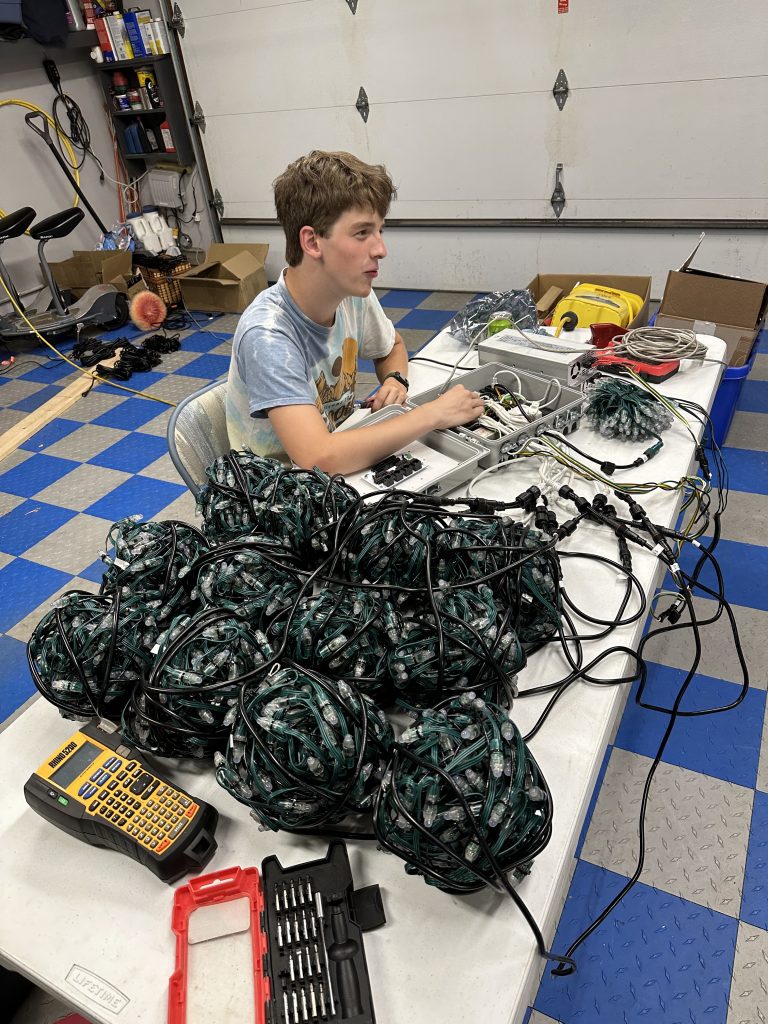
The other change we made was the a new topper. Our previous star topper’s frame was original to our first Mega Tree in 2003. Originally it had rope light, and in 2011 we switched that out with RGB light so the star could change colors. For 2023 we created a Moravian Star, which contains 43 pixels, so the star can have the points be different colors, “spin” around, or do many different pixel effects.
Here are some details about our pixel-based mega-tree:
- The tree is made up of 1536 RGB LED ‘bulbs’. Since these ‘bulbs’ are really pixel nodes, each one can be set to virtually any color, independently of each other bulb. This (in combination with software programming) can allow for many interesting effects, and even pictures, text, and video to be ‘played’ on the tree.It stood approximately 20 feet high and 10 feet in diameter.
- 12 miniature “curtain strobes” go down the center of the main pole and are used to provide a sparkling effect at certain times in the music.
- The tree stands approximately 20 feet high and 10 feet in diameter
- The primary structural element for tree is a telescoping flagpole. The telescoping nature of the flagpole allows the tree topper and lights to be installed near the ground, then the pole raised to its full 20 foot height.
- The base of the is constructed of 30′ of gray PVC conduit, which bends into a circle easily, and is supported by additional lengths of conduit supported by rebar into the ground.
- Each of the 1536 nodes has 3 computer-controlled channels (Red, Green, Blue), for a grand total of 4608 controllable channels on the tree itself. The star uses 132 additional channels, and the strobes have their own channel as well.
- The tree consists of 12 128-node pixel strings. Each string starts at the bottom, goes to the top (64 pixels, then comes back down the tree on the same side, forming somewhat of a “V”. This essentially means we have 24 64-pixel “drops” from the top of the tree to use in creating visual effects.
- Ten DMX “universes” are used to control the tree. This is done via a Falcon F16v3 pixel controller, which communicates with the show computer via the E1.31 DMX-over-ethernet protocol
- With all of the lights and the tree topper, there is a lot of weight on the flagpole, so we added some rubber drainage pipe clamps to help take the weight off of the pins that hold the pole up. The tree is also guy-roped from four directions to stabilize it.
- In 2011 we created a new tree topper for our old mega-tree using RGB flexible ribbon. The ribbon was first placed in a split opaque-plastic water tube to give it better color distribution. The new lights are controlled by a small DMX controller and 3 computer channels, each controlling the Red, Green, and Blue elements. Those three primary colors can be mixed to create just about any color for the star. This topper continued to be used on our pixel mega tree until it’s next refresh for the 2023 season, when we created a new Moravian Star, which has its own page describing its construction.
For more details on the construction and setup of the basic structure of the tree, check out our page on our original Mega Tree, which also includes a setup video of that tree.

